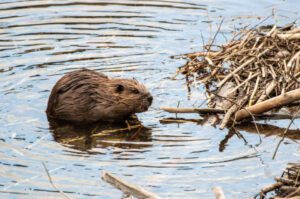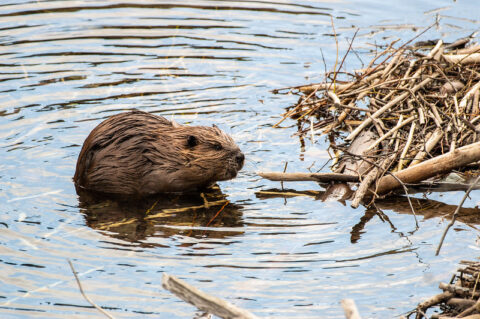Beavers in Jackson Hole

Knock, knock. Who’s there? Beaver. Beaver, who? Beaver-y glad that beaver restoration in Jackson is well underway! (And be very glad you won’t have to suffer through another joke like that, too.) After decades of trapping in the early to mid-1800s that decimated the beaver population, wildlife biologists and conservationists are happy to report that the restoration of this keystone species is going well. (We’re sure you’ve been on the edge of your seat wondering.) Great question. I didn’t know either. A keystone species is defined as one that has a disproportionately large impact on their environment relative to their abundance. Think of the small pebble thrown into a pool analogy. Its effects ripple out much further. These keystone species can be predators, prey, ecosystem engineers (beavers), habitat providers, or pollinators. So basically anything.
Great question. I didn’t know either. A keystone species is defined as one that has a disproportionately large impact on their environment relative to their abundance. Think of the small pebble thrown into a pool analogy. Its effects ripple out much further. These keystone species can be predators, prey, ecosystem engineers (beavers), habitat providers, or pollinators. So basically anything.
(n.d.). About Beavers. Beavers Northwest. Retrieved October 25, 2023, from https://beaversnw.org/about-beavers Defenders of Wildlife (2023, February 16). What is a Keystone Species. Retrieved October 25, 2023, from https://defenders.org/blog/2023/02/what-keystone-species Smithsonian's National Zoo & Conservation Biology Institute (2019, April 19). 8 Facts to Celebrate International Beaver Day. Animal News Archive. Retrieved October 25, 2023, from https://nationalzoo.si.edu/animals/news/8-facts-celebrate-international-beaver-day U.S. DEPARTMENT OF AGRICULTURE (n.d.). Early Trappers. Forest Service. Retrieved October 25, 2023, from https://www.fs.usda.gov/detail/btnf/learning/history-culture/?cid=fsbdev3_063669#main_content
What is a keystone species?
 Great question. I didn’t know either. A keystone species is defined as one that has a disproportionately large impact on their environment relative to their abundance. Think of the small pebble thrown into a pool analogy. Its effects ripple out much further. These keystone species can be predators, prey, ecosystem engineers (beavers), habitat providers, or pollinators. So basically anything.
Great question. I didn’t know either. A keystone species is defined as one that has a disproportionately large impact on their environment relative to their abundance. Think of the small pebble thrown into a pool analogy. Its effects ripple out much further. These keystone species can be predators, prey, ecosystem engineers (beavers), habitat providers, or pollinators. So basically anything.So the beaver fits in this category?
Arguably, a beaver is THE keystone species in Jackson Hole. Beavers create some of the largest ecosystems in the region. A Buckrail article notes “beavers shift the landscape by building dams, primarily forming the larger, deeper ponds for their own safety; beavers use the water depth they create to hide from predators. But the impact of the pond is huge. … Beaver ponds have similar biodiversity to coral reefs and tropical rainforests. The ponds are able to support trout populations, moose, sage grouse chicks who need nutrients, ducks, swans, and more.” They do all this AND lead the Pevensie children to Aslan in Lion, the Witch, and the Wardrobe. (Start at 8:35 for an accurate depiction of what Wookiees beavers do in their dens.) Pretty incredible and not at all horrifying, right?What happened to all the beavers anyway?
The exploration of what is now known as the Bridger-Teton National Forest began around 1807 to 1808. John Colter traveled with the Lewis and Clark expedition to the Pacific Northwest but left on the return journey and is thought to be the first of the mountain men to explore the region. Others soon followed, including John Jacob Astor, establishing trading posts on the Pacific Coast. The streams and rivers in northern Wyoming became well known as beaver trapping country and, for the next 20 years, the trapping industry boomed. Before European settlement of North America, there were an estimated 60-400 million beavers. The beaver population was decimated through the 1700s and 1800s and by the early 1900s, their numbers were dwindling. Due to the work of wildlife biologists (and beaver pelts going out of fashion; I mean, when was the last time the cool kid in school wore a tall beaver hat?), more recent estimates put the beaver population around 6-12 million.Give me more beaver facts.
Common name: Beaver Scientific name: Castor canadensis Type: Mammal Diet: Herbivore Average lifespan in the wild: 24 years Size: Head and body: 23 to 29 inches; tail: 7.75 inches to 12 inches Weight: 60 pounds Fun fact: Beavers are the second largest rodent in the world. Let’s give a round of applause to these amazing ecosystem engineers, conservationists, and wildlife biologists who helped bring this population back from the brink. This post was brought to you by Flat Creek Inn. Breanne Kunz was raised in the Pacific Northwest but grew up spending summers in Idaho and frequently visiting Jackson Hole, Grand Teton National Park, and Yellowstone National Park. She is a wife and mom who likes to write. She likes beavers as much as the next person, which is to say that the beaver is maybe number 37 on her list of favorite animals.(n.d.). About Beavers. Beavers Northwest. Retrieved October 25, 2023, from https://beaversnw.org/about-beavers Defenders of Wildlife (2023, February 16). What is a Keystone Species. Retrieved October 25, 2023, from https://defenders.org/blog/2023/02/what-keystone-species Smithsonian's National Zoo & Conservation Biology Institute (2019, April 19). 8 Facts to Celebrate International Beaver Day. Animal News Archive. Retrieved October 25, 2023, from https://nationalzoo.si.edu/animals/news/8-facts-celebrate-international-beaver-day U.S. DEPARTMENT OF AGRICULTURE (n.d.). Early Trappers. Forest Service. Retrieved October 25, 2023, from https://www.fs.usda.gov/detail/btnf/learning/history-culture/?cid=fsbdev3_063669#main_content

